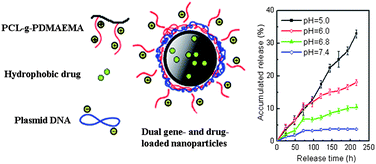pH-dependent temperature- sensitive poly(ε-caprolactone)-graft-poly(2-(dimethylamino) ethyl methacrylate) (PCL-g-PDMAEMA), a kind of degradable, amphiphilic, cationic copolymer, was synthesized. PCL-g-PDMAEMA was self-assembled into core-shell nanoparticles with an ultralow critical association concentration at about 8.1 × 10−4 g L−1. It was found that PCL-g-PDMAEMA nanoparticles were able to simultaneously entrap hydrophobic paclitaxel and load DNA. Hydrophobic drug paclitaxel, loaded by PCL-g-PDMAEMA NPs, could be released faster in an acidic environment than in a neutral environment, and PCL-g-PDMAEMA NPs showed a comparable in vitro gene transfection efficiency to Lipofectamine 2000. In addition, the gene transfection efficiency was enhanced by the addition of 5% serum. Besides, confocal microscopic measurements indicated that PCL-g-PDMAEMA nanoparticles/DNA polyplexes could escape from the endosome and release the payloads effectively in cytoplasm. These results suggest PCL-g-PDMAEMA has great potential for achieving the synergistic effect of drug and gene therapies in vivo.

You have access to this article
 Please wait while we load your content...
Something went wrong. Try again?
Please wait while we load your content...
Something went wrong. Try again?


 Please wait while we load your content...
Please wait while we load your content...